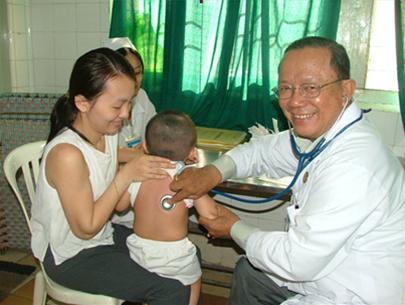Acute bronchitis caused by viruses is showing erratic trends and accounts for over 60% of pediatric admissions at Children’s Hospital 2. The hot weather of the past week is a characteristic sign of the complex changes during the transitional season.
This is typically a time when there are unusual disease outbreaks and end-of-summer illnesses affecting children. Dr. Tran Huu Nhon, Head of the General Internal Medicine Department 1 at Children’s Hospital 2 (Ho Chi Minh City), stated that during this weather, children commonly contract the following five types of illnesses:
1. Viral Acute Bronchitis:
This is the main respiratory infection in children in recent days, accounting for up to 60% of pediatric admissions at Children’s Hospital 2. This infection can occur in any part of a child’s lungs.
The illness usually starts with a persistent dry cough that gradually worsens without producing sputum. When the child exhales, wheezing may be heard in the bronchi. The cough is often persistent, followed by the appearance of thick mucus. After 7-10 days, the mucus decreases and the cough gradually subsides.
Causes: It is commonly caused by various types of viruses, so it is essential to differentiate it from whooping cough, tuberculosis, diphtheria, and asthma.
In young children, congenital airway deformities or foreign body aspiration must also be ruled out.
This illness can lead to complications such as otitis media, sinusitis, and pneumonia. Therefore, it is crucial to take the child to a healthcare facility for treatment promptly. As the disease is contagious, it is necessary to isolate the sick child. To prevent infection, children should wear masks outdoors to avoid dust, and they should receive vaccinations or preventive medications on schedule.
Ensure that the child is dressed warmly when outdoors, and if they get caught in the rain, they should be taken home quickly to be dried off and kept warm. Maintain a nutritious diet for the child, avoid keeping them up late, and limit exposure to cigarette smoke.

Dr. Tran Huu Nhon, Head of the General Internal Medicine Department 1 at Children’s Hospital 2 (Ho Chi Minh City)
conducting an examination for a pediatric patient (Photo: TTO)
2. High Fever with Convulsions due to Viruses
The most common manifestation is a child who appears healthy and is playing normally but suddenly shows signs of fatigue with a rapid onset of high fever accompanied by convulsions, which can alarm parents.
Before taking the child to the hospital, parents and caregivers should remain calm and manage the convulsions by performing specific actions such as cooling the body with a damp cloth soaked in water that is at least 2 degrees lower than the child’s current temperature.
For example, if the child has a fever of 39 degrees Celsius, the water should be below 37 degrees Celsius; avoid using ice or lemon juice. It is essential to administer a dose of Paracetamol (the rectal form) of 10-20 mg/kg of body weight by rectum.
3. Rash Fever
Initial symptoms often include fever, cough, runny nose, and the appearance of a rash. Initially, the rash appears on the face before spreading to the abdomen, arms, and legs. A distinguishing feature of the rash from fever is that it typically presents as fine red spots, with no broken capillaries.
The rash usually subsides after 3 days without reappearing and can occur multiple times.
Children with rash fever typically do not cause much alarm for parents compared to those with high fever and convulsions, but they are often recognized late, leading to various consequences due to negligence.
Home care process: It is important to only feed the child foods that are less likely to cause skin allergies, such as seafood, crabs, and snails. Cleaning and hygiene for the child should only be done at noon, using warm water and quick washing.
4. Severe Dehydrating Acute Diarrhea
Food and drink, especially street food, during this time are often contaminated by bacteria such as E. Coli and Vibrio cholerae. Bacteria or viruses can enter the intestines through food, causing acute enteritis and disrupting absorption.
The illness usually begins abruptly with diarrhea symptoms such as vomiting, followed by watery stools that may contain mucus, blood, or greenish stools, accompanied by abdominal pain, fever, and bloating.
In severe dehydrating acute diarrhea, two out of the following four characteristic signs may be present: lethargy or coma, sunken eyes, thirst without the ability to drink or very little intake, and a slow recoil of the skin when pinched. In this condition, it is essential to replenish the child’s fluids immediately; if the child cannot drink, intravenous fluids with Lactated Ringer’s solution should be administered, and the child should be urgently taken to a healthcare facility for emergency care.
5. Meningitis
This condition is caused by bacteria or viruses that infect the central nervous system. Early diagnosis is critical for prompt treatment to prevent brain damage and neurological complications.
Clinical signs include fever, drowsiness, headache, a stiff neck, bulging fontanelle (in young children), seizures, and signs of neurological positioning.
The doctor may observe Kernig’s sign and Brudzinski’s sign during clinical examination, and sometimes nerve paralysis may occur.
Prevention measures include vaccinating children, avoiding contact with children who have meningitis, and maintaining hygienic living and eating conditions.
Dr. TRAN HUU NHON

















































